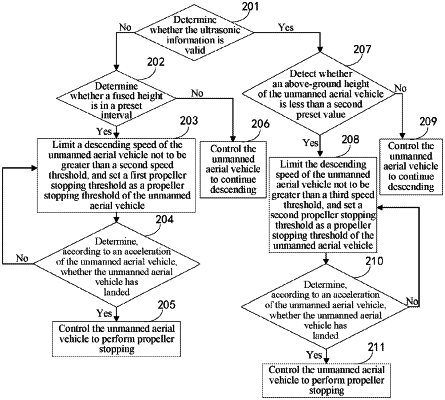| CPC B64D 45/04 (2013.01) [B64C 39/024 (2013.01); G05D 1/106 (2019.05); B64D 2045/008 (2013.01); B64U 10/13 (2023.01); B64U 70/00 (2023.01); B64U 2201/10 (2023.01); G08G 5/0069 (2013.01)] | 13 Claims |

|
1. An unmanned aerial vehicle safety protection method, the method comprising:
obtaining ultrasonic information and a flight status of an unmanned aerial vehicle, wherein the flight status comprises a normal flight state and a descending state; the ultrasonic information is obtained by an ultrasonic sensor; and
performing safety protection on the unmanned aerial vehicle according to the ultrasonic information and the flight status;
wherein when the flight status is the descending state, the performing safety protection on the unmanned aerial vehicle according to the ultrasonic information and the flight status comprises:
determining whether the ultrasonic information is valid;
in response to the ultrasonic information is invalid, determining whether a fused height is in a preset interval; and
in response to the fused height is in the preset interval, limiting a descending speed of the unmanned aerial vehicle not to be greater than a second speed threshold, and setting a first propeller stopping threshold as a propeller stopping threshold of the unmanned aerial vehicle;
determining, according to an acceleration of the unmanned aerial vehicle, whether the unmanned aerial vehicle has landed;
controlling the unmanned aerial vehicle to perform propeller stopping, if the unmanned aerial vehicle has landed; and
in response to the unmanned aerial vehicle has not landed, limiting the descending speed of the unmanned aerial vehicle not to be greater than the second speed threshold, and setting the first propeller stopping threshold as the propeller stopping threshold of the unmanned aerial vehicle;
wherein the determining whether the unmanned aerial vehicle has landed comprises:
obtaining a Z-axis acceleration Az and a specific thrust T of the unmanned aerial vehicle;
calculating a value of A according to a formula A=−Az−T; and
determining whether the value of A is greater than the first propeller stopping threshold, wherein if the value of A is greater than the first propeller stopping threshold, the unmanned aerial vehicle has landed, or if the value of A is not greater than the first propeller stopping threshold, the unmanned aerial vehicle has not landed.
|